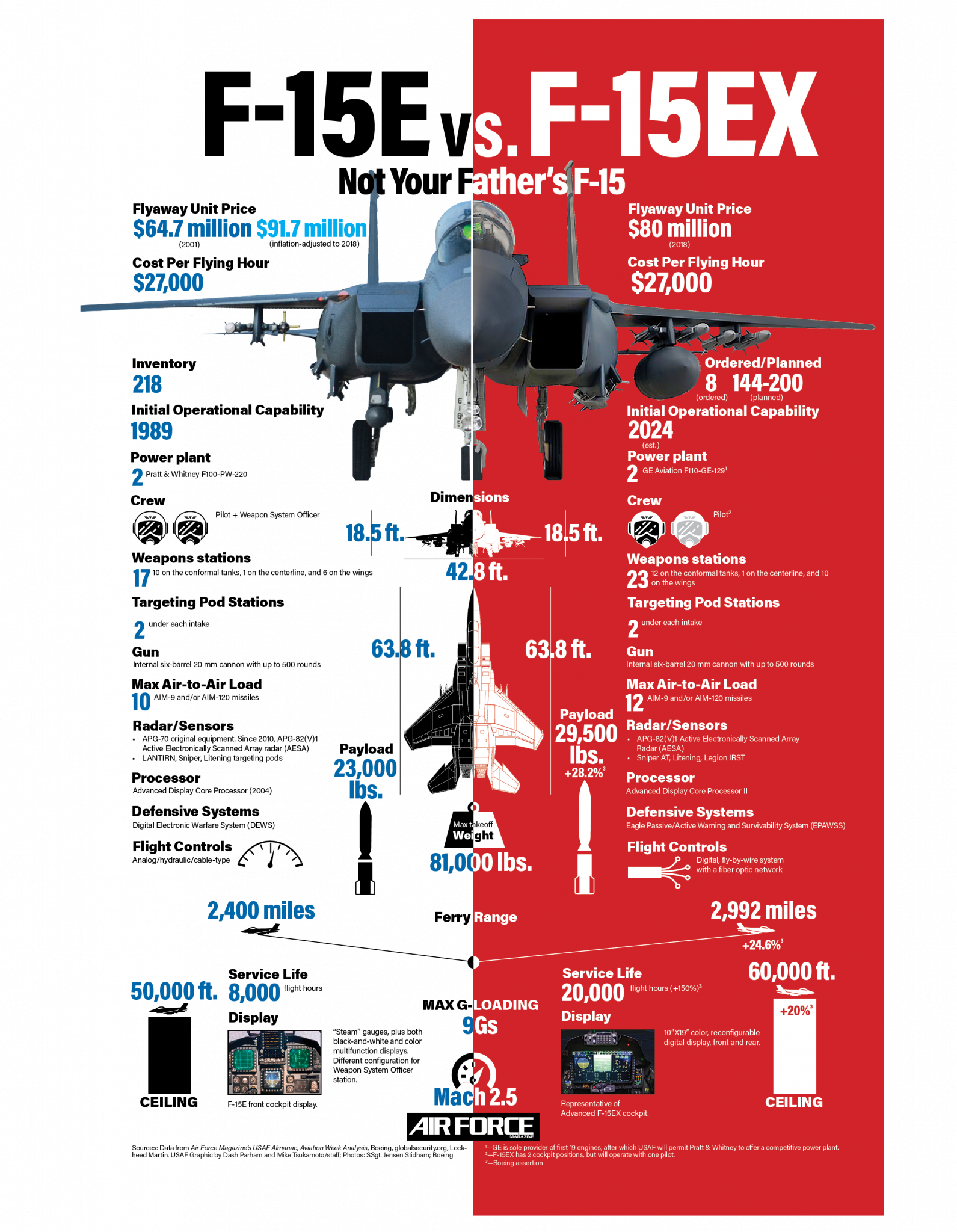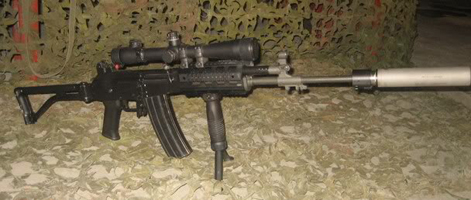USAF News
Moderadores: Glauber Prestes, Conselho de Moderação
- cabeça de martelo
- Sênior

- Mensagens: 38219
- Registrado em: Sex Out 21, 2005 10:45 am
- Localização: Portugal
- Agradeceram: 2649 vezes
- jambockrs
- Sênior

- Mensagens: 2617
- Registrado em: Sex Jun 10, 2005 1:45 am
- Localização: Porto Alegre/RS
- Agradeceram: 180 vezes
Re: USAF News
Meus prezados
Força Aérea dos EUA atualizará seus treinadores primários T-6A Texan II
Por Alexandre Galante
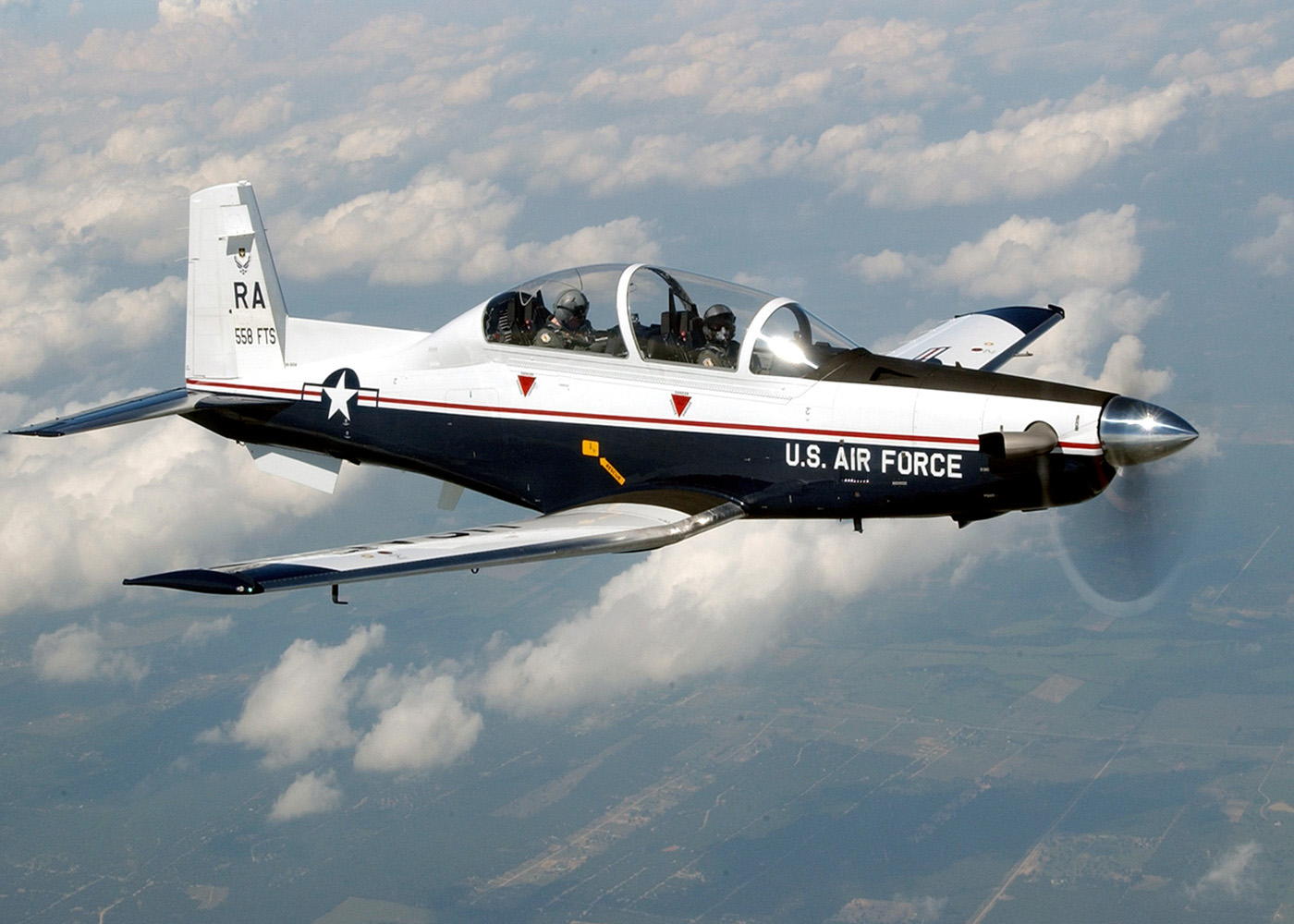
A Divisão de Treinadores do Centro de Gerenciamento do Ciclo de Vida da Força Aérea dos EUA está procurando contratados que possam ser capazes e dispostos a desenvolver, entregar e integrar uma substituição de sistema aviônico abrangente para o treinador principal T-6A.
A Força Aérea lançou um rascunho de solicitação de propostas para empreiteiros interessados em desenvolver e entregar um substituto do sistema aviônico para a aeronave T-6A Texan II.
O atual sistema aviônico federado T-6A é composto de componentes analógicos e digitais de primeira geração que têm sido cada vez mais afetados por problemas de obsolescência nos últimos anos, resultando em diminuição da confiabilidade dos componentes, diminuição das taxas de disponibilidade de aeronaves e aumento dos custos de manutenção do ciclo de vida.
Em um aviso, a Força Aérea anunciou que uma substituição abrangente do sistema aviônico está sendo considerada para resolver os problemas de obsolescência e posicionar o T-6A para uma estrutura de sustentação do ciclo de vida dos aviônicos de longo prazo que seja confiável e econômica.
O sistema aviônico de substituição exigiria integração com a configuração do T-6A no momento da instalação e seria capaz de se adaptar às mudanças na configuração do T-6A ao longo do tempo. O objetivo desejado é entender os recursos dos sistemas aviônicos disponíveis que são compatíveis e interoperáveis com o T-6A.
O T-6A é um derivado do Beechcraft PC-9 Mk II que foi fabricado pela Textron Aviation Defense (TAD) e é movido por um único motor turboélice PT-6A-68 Pratt & Whitney. A frota conjunta T-6A da Força Aérea e da Marinha é gerenciada pelo T-6 Program Office em Tinker AFB em coordenação com a Program Management Administration, (PMA) -273 localizada na Naval Air Station Patuxeunt River.
A Força Aérea utiliza o T-6A para conduzir o treinamento primário de pilotos, que inclui a exposição dos pilotos iniciantes ao ambiente da cabine e táticas básicas associadas à navegação, formação e operação da aeronave. A frota T-6A da Força Aérea opera a partir das Alas de Treinamento do Comando de Educação e Treinamento Aéreo (AETC) localizadas em Columbus AFB, Laughlin AFB, Randolph AFB, Sheppard AFB, Vance AFB e Naval Air Station (NAS) Pensacola. Além disso, a Marinha utiliza o T-6A para conduzir o treinamento de Combat Systems Officer (CSO) na NAS Pensacola ao lado da Força Aérea.

Cockpit atual do T-6A Texan II
Fonte: blog Poder Aéreo 10 mar 2021
Força Aérea dos EUA atualizará seus treinadores primários T-6A Texan II
Por Alexandre Galante

A Divisão de Treinadores do Centro de Gerenciamento do Ciclo de Vida da Força Aérea dos EUA está procurando contratados que possam ser capazes e dispostos a desenvolver, entregar e integrar uma substituição de sistema aviônico abrangente para o treinador principal T-6A.
A Força Aérea lançou um rascunho de solicitação de propostas para empreiteiros interessados em desenvolver e entregar um substituto do sistema aviônico para a aeronave T-6A Texan II.
O atual sistema aviônico federado T-6A é composto de componentes analógicos e digitais de primeira geração que têm sido cada vez mais afetados por problemas de obsolescência nos últimos anos, resultando em diminuição da confiabilidade dos componentes, diminuição das taxas de disponibilidade de aeronaves e aumento dos custos de manutenção do ciclo de vida.
Em um aviso, a Força Aérea anunciou que uma substituição abrangente do sistema aviônico está sendo considerada para resolver os problemas de obsolescência e posicionar o T-6A para uma estrutura de sustentação do ciclo de vida dos aviônicos de longo prazo que seja confiável e econômica.
O sistema aviônico de substituição exigiria integração com a configuração do T-6A no momento da instalação e seria capaz de se adaptar às mudanças na configuração do T-6A ao longo do tempo. O objetivo desejado é entender os recursos dos sistemas aviônicos disponíveis que são compatíveis e interoperáveis com o T-6A.
O T-6A é um derivado do Beechcraft PC-9 Mk II que foi fabricado pela Textron Aviation Defense (TAD) e é movido por um único motor turboélice PT-6A-68 Pratt & Whitney. A frota conjunta T-6A da Força Aérea e da Marinha é gerenciada pelo T-6 Program Office em Tinker AFB em coordenação com a Program Management Administration, (PMA) -273 localizada na Naval Air Station Patuxeunt River.
A Força Aérea utiliza o T-6A para conduzir o treinamento primário de pilotos, que inclui a exposição dos pilotos iniciantes ao ambiente da cabine e táticas básicas associadas à navegação, formação e operação da aeronave. A frota T-6A da Força Aérea opera a partir das Alas de Treinamento do Comando de Educação e Treinamento Aéreo (AETC) localizadas em Columbus AFB, Laughlin AFB, Randolph AFB, Sheppard AFB, Vance AFB e Naval Air Station (NAS) Pensacola. Além disso, a Marinha utiliza o T-6A para conduzir o treinamento de Combat Systems Officer (CSO) na NAS Pensacola ao lado da Força Aérea.

Cockpit atual do T-6A Texan II
Fonte: blog Poder Aéreo 10 mar 2021
- jambockrs
- Sênior

- Mensagens: 2617
- Registrado em: Sex Jun 10, 2005 1:45 am
- Localização: Porto Alegre/RS
- Agradeceram: 180 vezes
Re: USAF News
Meus prezados
USAF recebe segundo B-52 do cemitério
por Luiz Padilha

B-52 Wise Guy em voo após restauração
Por Gareth Jennings
A Força Aérea dos Estados Unidos (USAF) reformou e voltou a operar um segundo bombardeiro estratégico Boeing B-52 Stratofortress do “cemitério” da Base Aérea Davis-Monthan (AFB) no Arizona.
A aeronave 60-034 havia sido armazenada pelo 309º Grupo de Manutenção e Regeneração Aeroespacial desde 2008. Ela foi transportada da Base Aérea Davis-Monthan para a Base Aérea Barksdale, Louisiana, em maio de 2019, antes da reforma e entrega em sua nova casa, a Base Aérea Minot, Dakota do Norte, em 9 de março.
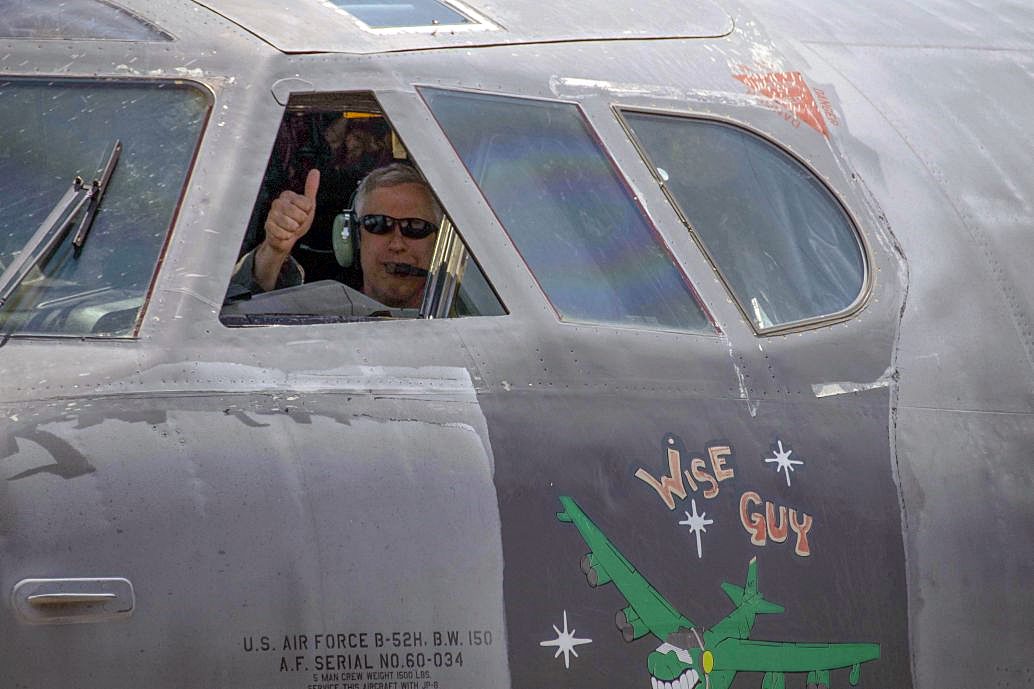
Bombardeiro B-52 após seu vôo inaugural do cemitério em 2019, (Força aérea dos Estados Unidos)
Apelidada de ‘Wise Guy’, esta aeronave exigiu 550 pessoas em várias disciplinas de manutenção para restaurá-la, custando aproximadamente US$ 30 milhões. O ‘Wise Guy’ é um dos dois bombardeiros B-52H recentemente retornados ao serviço para trazer a frota de volta para 77 unidades após duas perdas por acidente.
A primeira aeronave, apelidada de 'Ghost Rider’, voou da Base Aérea Davis-Monthan para a Base Aérea Barksdale em 2015 e entregue à Base Aérea Minot em setembro de 2016*. No auge de sua força, as forças com B-52 da Força Aérea dos EUA (USAF) compreendia cerca de 744 aeronaves, embora esse número tenha sido reduzido de acordo com o Tratado de Redução de Armas Estratégicas (START) com a Rússia.
Fonte: Jane’s via blog Defesa Aérea & Naval 14 mar 2021
Tradução e adaptação: DAN
*https://www.airway.com.br/estados-unido ... -de-idade/
USAF recebe segundo B-52 do cemitério
por Luiz Padilha

B-52 Wise Guy em voo após restauração
Por Gareth Jennings
A Força Aérea dos Estados Unidos (USAF) reformou e voltou a operar um segundo bombardeiro estratégico Boeing B-52 Stratofortress do “cemitério” da Base Aérea Davis-Monthan (AFB) no Arizona.
A aeronave 60-034 havia sido armazenada pelo 309º Grupo de Manutenção e Regeneração Aeroespacial desde 2008. Ela foi transportada da Base Aérea Davis-Monthan para a Base Aérea Barksdale, Louisiana, em maio de 2019, antes da reforma e entrega em sua nova casa, a Base Aérea Minot, Dakota do Norte, em 9 de março.

Bombardeiro B-52 após seu vôo inaugural do cemitério em 2019, (Força aérea dos Estados Unidos)
Apelidada de ‘Wise Guy’, esta aeronave exigiu 550 pessoas em várias disciplinas de manutenção para restaurá-la, custando aproximadamente US$ 30 milhões. O ‘Wise Guy’ é um dos dois bombardeiros B-52H recentemente retornados ao serviço para trazer a frota de volta para 77 unidades após duas perdas por acidente.
A primeira aeronave, apelidada de 'Ghost Rider’, voou da Base Aérea Davis-Monthan para a Base Aérea Barksdale em 2015 e entregue à Base Aérea Minot em setembro de 2016*. No auge de sua força, as forças com B-52 da Força Aérea dos EUA (USAF) compreendia cerca de 744 aeronaves, embora esse número tenha sido reduzido de acordo com o Tratado de Redução de Armas Estratégicas (START) com a Rússia.
Fonte: Jane’s via blog Defesa Aérea & Naval 14 mar 2021
Tradução e adaptação: DAN
*https://www.airway.com.br/estados-unido ... -de-idade/
- cabeça de martelo
- Sênior

- Mensagens: 38219
- Registrado em: Sex Out 21, 2005 10:45 am
- Localização: Portugal
- Agradeceram: 2649 vezes
Re: USAF News
B-2s head to Portugal as surprise bomber flights spread
Rachel S. Cohen

Air Force Senior Airman Tony Nogales, left, and Airman 1st Class Byron Humphrey, 509th Aircraft Maintenance Squadron crew chiefs, conclude preflight checks in support of a bomber task force at Whiteman Air Force Base, Mo., March 16. (Staff Sgt. Sadie Colbert/Air Force)
Air Force B-2 Spirit bombers arrived at Portugal’s Lajes Field Tuesday, the service said this week, joining the B-1 Lancer bombers that are flying short-notice missions to project a strong front out of Europe.
An undisclosed number of B-2s from the 509th Bomb Wing at Whiteman Air Force Base, Missouri, “add even more depth” to bomber task force flights run by U.S. Air Forces in Europe-Air Forces Africa, the organization’s commander, Gen. Jeff Harrigian, said in a release Wednesday.
Bomber task force missions in Europe intend to show strength in defense of the NATO alliance by making adversaries think twice about a potential attack. B-2s are stopping off at Lajes Field for a quick, “hot-pit refuel,” where airmen gas up the plane with its engines still running before heading out to fly sorties.
The bombers will “perform mission-essential tasks during several upcoming … sorties,” the Air Force said, without elaborating on what the tasks entail. It’s unclear how long the B-2s, which can carry nuclear or conventional weapons, will stay overseas.
“The B-2′s low-observable, or ‘stealth,’ characteristics give it the ability to penetrate an enemy’s most sophisticated defenses and threaten its most-valued, heavily defended targets while avoiding adversary detection, tracking, and engagement,” the Air Force said.
Spirit bombers deployed to Portugal for task force missions in March 2020 as well, and have recently flown task force missions out of the island of Diego Garcia.
The Air Force plans to send its bombers to a broader range of places for frequent task force deployments throughout the year, Gen. Tim Ray, the head of Air Force Global Strike Command, told reporters last month. Bombers typically head to Diego Garcia, the United Kingdom, Spain and Guam, but will branch out to maintain a constant-yet-unpredictable presence in more areas of the world.
“What we did in [2020] is, I think, indicative of what we can sustain,” Ray said, according to Air Force Magazine. “We’re going to keep this pace up.”
https://www.airforcetimes.com/news/your ... ts-spread/
Rachel S. Cohen

Air Force Senior Airman Tony Nogales, left, and Airman 1st Class Byron Humphrey, 509th Aircraft Maintenance Squadron crew chiefs, conclude preflight checks in support of a bomber task force at Whiteman Air Force Base, Mo., March 16. (Staff Sgt. Sadie Colbert/Air Force)
Air Force B-2 Spirit bombers arrived at Portugal’s Lajes Field Tuesday, the service said this week, joining the B-1 Lancer bombers that are flying short-notice missions to project a strong front out of Europe.
An undisclosed number of B-2s from the 509th Bomb Wing at Whiteman Air Force Base, Missouri, “add even more depth” to bomber task force flights run by U.S. Air Forces in Europe-Air Forces Africa, the organization’s commander, Gen. Jeff Harrigian, said in a release Wednesday.
Bomber task force missions in Europe intend to show strength in defense of the NATO alliance by making adversaries think twice about a potential attack. B-2s are stopping off at Lajes Field for a quick, “hot-pit refuel,” where airmen gas up the plane with its engines still running before heading out to fly sorties.
The bombers will “perform mission-essential tasks during several upcoming … sorties,” the Air Force said, without elaborating on what the tasks entail. It’s unclear how long the B-2s, which can carry nuclear or conventional weapons, will stay overseas.
“The B-2′s low-observable, or ‘stealth,’ characteristics give it the ability to penetrate an enemy’s most sophisticated defenses and threaten its most-valued, heavily defended targets while avoiding adversary detection, tracking, and engagement,” the Air Force said.
Spirit bombers deployed to Portugal for task force missions in March 2020 as well, and have recently flown task force missions out of the island of Diego Garcia.
The Air Force plans to send its bombers to a broader range of places for frequent task force deployments throughout the year, Gen. Tim Ray, the head of Air Force Global Strike Command, told reporters last month. Bombers typically head to Diego Garcia, the United Kingdom, Spain and Guam, but will branch out to maintain a constant-yet-unpredictable presence in more areas of the world.
“What we did in [2020] is, I think, indicative of what we can sustain,” Ray said, according to Air Force Magazine. “We’re going to keep this pace up.”
https://www.airforcetimes.com/news/your ... ts-spread/
- cabeça de martelo
- Sênior

- Mensagens: 38219
- Registrado em: Sex Out 21, 2005 10:45 am
- Localização: Portugal
- Agradeceram: 2649 vezes
- cabeça de martelo
- Sênior

- Mensagens: 38219
- Registrado em: Sex Out 21, 2005 10:45 am
- Localização: Portugal
- Agradeceram: 2649 vezes
Re: USAF News
The B-21 Raider Is on Time and on Budget. That’s a Miracle.
Military procurement success stories are rare, to say the least.

he U.S. Air Force’s forthcoming B-21 Raider bomber isn’t only on budget—it’s also (mostly) on time. That might as well be a miracle in the messy world of military hardware procurement.
You love badass planes. So do we. Let’s nerd out over them together.
The B-21 Raider is the Air Force’s next strategic bomber. The bomber, which outwardly resembles the B-2 Spirit stealth bomber, will replace both the B-1 Lancer and B-2 Spirit. The B-21 will be a dual capable bomber, which means it can carry either nuclear or conventional weapons. The Air Force plans to buy at least 100 of the planes for a maximum of $665 million.
Military procurement programs of all flavors tend to take longer than anticipated and cost more than estimated. The U.S. Army, for example, spent 6 years finding a replacement for the M9 handgun, finally picking the M17/M18 series of handguns in 2017. The Air Force’s KC-46A Pegasus tanker, meanwhile, is 7 years behind budget and costs $4.6 billion more than originally quoted.
But there’s one ray of hope in the Pentagon budget, and it’s seemingly in the most unlikely of places. Rep. Adam Smith (D-Wash.), the chairman of the House Armed Services Committee, recently said the B-21 is “on time, on budget, and they’re making it work in a very intelligent way,” according to Breaking Defense.
Speaking at a recent think tank event, Smith also said he was “relatively upbeat” about the B-21 program after the delays and overruns of the F-35 Joint Strike FIghter, and cautioned that things could “quickly go sideways” once the airplane started flying.
It’s fair to say most people expected the B-21 to blow its timetable and budget. Armed warplanes are among the most notorious military spending programs, and adding a nuclear capability tends to exacerbate both. The B-2 famously went over budget in the late 1980s and early 1990s, though a major part of that was a late-stage redesign that required the plane to be capable of low-altitude flight. As a result of the redesign (and the end of the Cold War), the B-2 fleet went from a planned 132 aircraft to just 21.
While the B-21 has slipped a tiny bit—the first Raider was supposed to fly in December 2021, and it’s now scheduled for sometime in 2022—the plane has also stayed on budget, and that’s the more important thing.
The Air Force plans to buy 100 B-21s, but would really like 220 of the bombers. If the plane can stick to schedule and not break the bank, that would help the Air Force make the case for a larger fleet.
https://www.popularmechanics.com/milita ... r-updates/
Military procurement success stories are rare, to say the least.

he U.S. Air Force’s forthcoming B-21 Raider bomber isn’t only on budget—it’s also (mostly) on time. That might as well be a miracle in the messy world of military hardware procurement.
You love badass planes. So do we. Let’s nerd out over them together.
The B-21 Raider is the Air Force’s next strategic bomber. The bomber, which outwardly resembles the B-2 Spirit stealth bomber, will replace both the B-1 Lancer and B-2 Spirit. The B-21 will be a dual capable bomber, which means it can carry either nuclear or conventional weapons. The Air Force plans to buy at least 100 of the planes for a maximum of $665 million.
Military procurement programs of all flavors tend to take longer than anticipated and cost more than estimated. The U.S. Army, for example, spent 6 years finding a replacement for the M9 handgun, finally picking the M17/M18 series of handguns in 2017. The Air Force’s KC-46A Pegasus tanker, meanwhile, is 7 years behind budget and costs $4.6 billion more than originally quoted.
But there’s one ray of hope in the Pentagon budget, and it’s seemingly in the most unlikely of places. Rep. Adam Smith (D-Wash.), the chairman of the House Armed Services Committee, recently said the B-21 is “on time, on budget, and they’re making it work in a very intelligent way,” according to Breaking Defense.
Speaking at a recent think tank event, Smith also said he was “relatively upbeat” about the B-21 program after the delays and overruns of the F-35 Joint Strike FIghter, and cautioned that things could “quickly go sideways” once the airplane started flying.
It’s fair to say most people expected the B-21 to blow its timetable and budget. Armed warplanes are among the most notorious military spending programs, and adding a nuclear capability tends to exacerbate both. The B-2 famously went over budget in the late 1980s and early 1990s, though a major part of that was a late-stage redesign that required the plane to be capable of low-altitude flight. As a result of the redesign (and the end of the Cold War), the B-2 fleet went from a planned 132 aircraft to just 21.
While the B-21 has slipped a tiny bit—the first Raider was supposed to fly in December 2021, and it’s now scheduled for sometime in 2022—the plane has also stayed on budget, and that’s the more important thing.
The Air Force plans to buy 100 B-21s, but would really like 220 of the bombers. If the plane can stick to schedule and not break the bank, that would help the Air Force make the case for a larger fleet.
https://www.popularmechanics.com/milita ... r-updates/
- cabeça de martelo
- Sênior

- Mensagens: 38219
- Registrado em: Sex Out 21, 2005 10:45 am
- Localização: Portugal
- Agradeceram: 2649 vezes
Re: USAF News
F-15EX To Carry New Oversized Air-To-Air Missile
The disclosure of the mysterious weapon reflects U.S. plans to challenge China’s long-range missile developments.
BY THOMAS NEWDICK
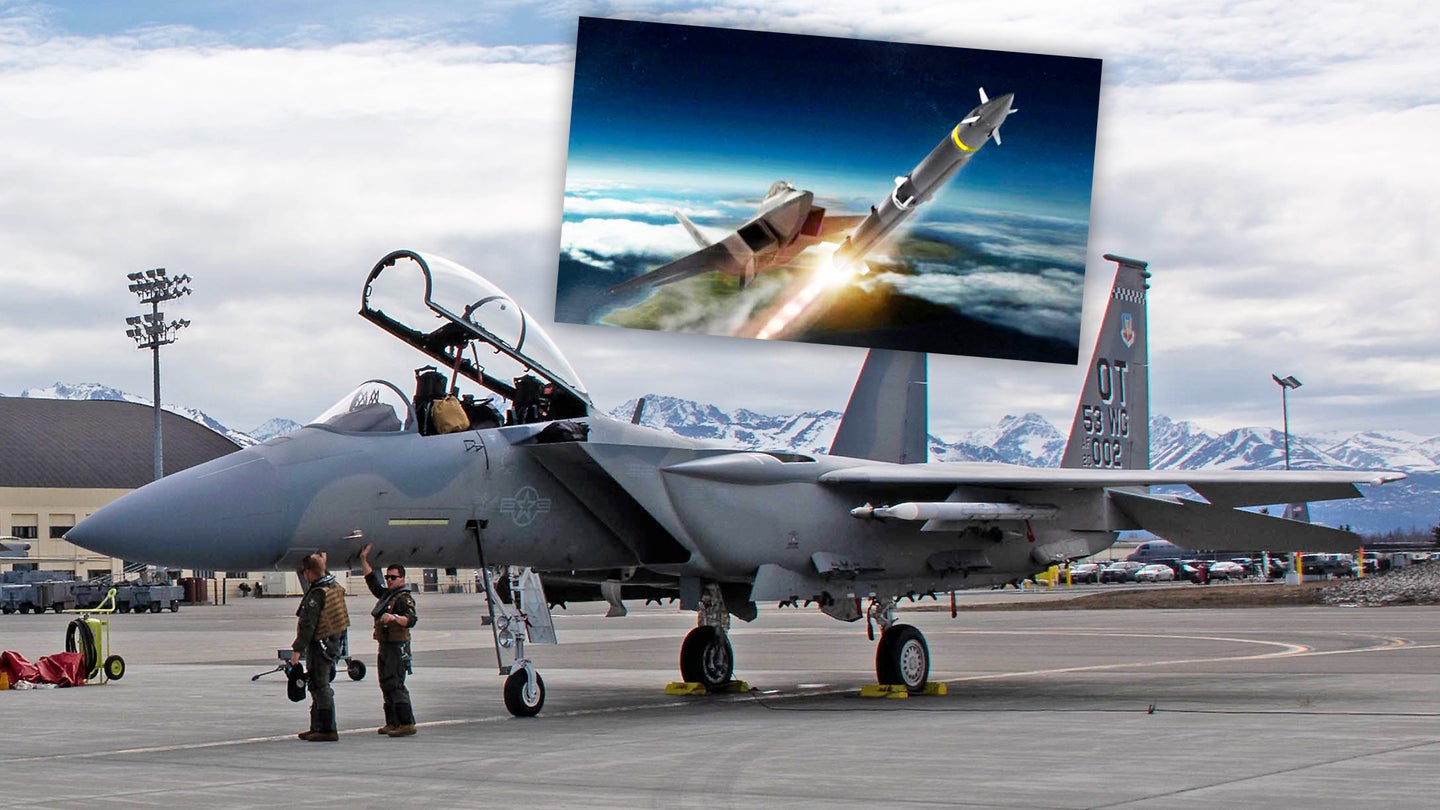
The U.S. Air Force just dropped a big hint that it’s working on a new very long-range air-to-air missile, with the F-15EX Eagle II fighter jet earmarked as the most likely candidate to carry it. The development is the first we’ve heard about a new U.S. air-to-air missile (AAM) in this class since the emergence of the Long Range Engagement Weapon, or LREW, some years ago, followed by that weapon’s apparent disappearance — at least in the public domain.
Details about the new missile were disclosed by Air Force Magazine which recently obtained a series of Air Force talking points for the Fiscal Year 2022 budget. These also talk more generally about the Air Force’s plans to retire over 400 older fighters and replace them with around 300 new aircraft, including the secretive Next Generation Air Dominance (NGAD) program and a ‘clean-sheet’ F-16 replacement, now called the Multi-Role fighter (MR-X).
Intriguingly, the talking points also make reference to an unnamed “outsize … air-to-air” weapon, which will be able to be carried by the F-15EX. The fighter is described in the same papers as “an outsized weapons truck.” To date, the largest air-to-air weapon associated with the F-15EX was the standard AIM-120 Advanced Medium-Range Air-to-Air Missile, or AMRAAM. While the Air Force has continued to try and wring out the maximum possible range from the AMRAAM, that weapon is now surely nearing the end of its development potential.
Previously, the ability of the F-15EX to carry outsized weapons was well known but it was always expected that these would be offensive air-to-ground weapons, including hypersonic missiles which are invariably larger than most regular air-launched missiles. In particular, the AGM-183A Air-launched Rapid Response Weapon, or ARRW, has been touted as a possible future armament option for the F-15EX.
Now, it seems, the F-15EX’s weapons carriage capability will likely see it hauling different types of standoff weapons to prosecute targets both on the ground and in the air. In both scenarios, the F-15EX would likely be operating in less-contested airspace, or just outside hostile anti-access and area denial (A2/AD) umbrellas.
Interestingly, while we know the Air Force, together with the Navy, is already working on a new AAM, which is intended to offer greater range than the current AIM-120 AMRAAM, the AIM-260 has long been assumed to be scaled to similar dimensions as the AMRAAM, especially as the F-22 Raptor is slated to be among the first aircraft to receive it. Having the AIM-260 broadly AMRAAM-sized would ensure it is suitable for internal carriage aboard the F-35 Lightning II, too, as well as any forthcoming stealth fighter designs. The AIM-260 is currently in development but details of its design and capabilities remain classified.
Aside from the AIM-260, there has been speculation in the past that the AGM-88G Advanced Anti-Radiation Guided Missile-Extended Range, or AARGM-ER, a radar-killing air-to-ground weapon, would make a suitable candidate to turn into a long-range AAM. Once again, however, that weapon has been sized from the outset to fit inside the weapons bays of the F-35A and the carrier-based F-35C.
Furthermore, by explicitly referring to the “outsize” nature of this new weapon, the Air Force would seem to be pointing to a different weapon altogether, one that Air Force Magazine assesses as a planned counter to China’s PL-15 AAM.
The PL-15 also remains a mysterious weapon. We know that it is intended as the main armament of the J-20 stealth fighter and that it’s broadly analogous to the AIM-120D AMRAAM. However, there has been speculation in the past surrounding exactly how it achieves its presumed very long-range and whether it uses exotic throttleable ramjet propulsion. In fact, it now seems certain that the PL-15 uses a more conventional dual-pulse motor, but that its overall performance and its active electronically scanned array (AESA) radar still offer a serious challenge to the United States and its allies.
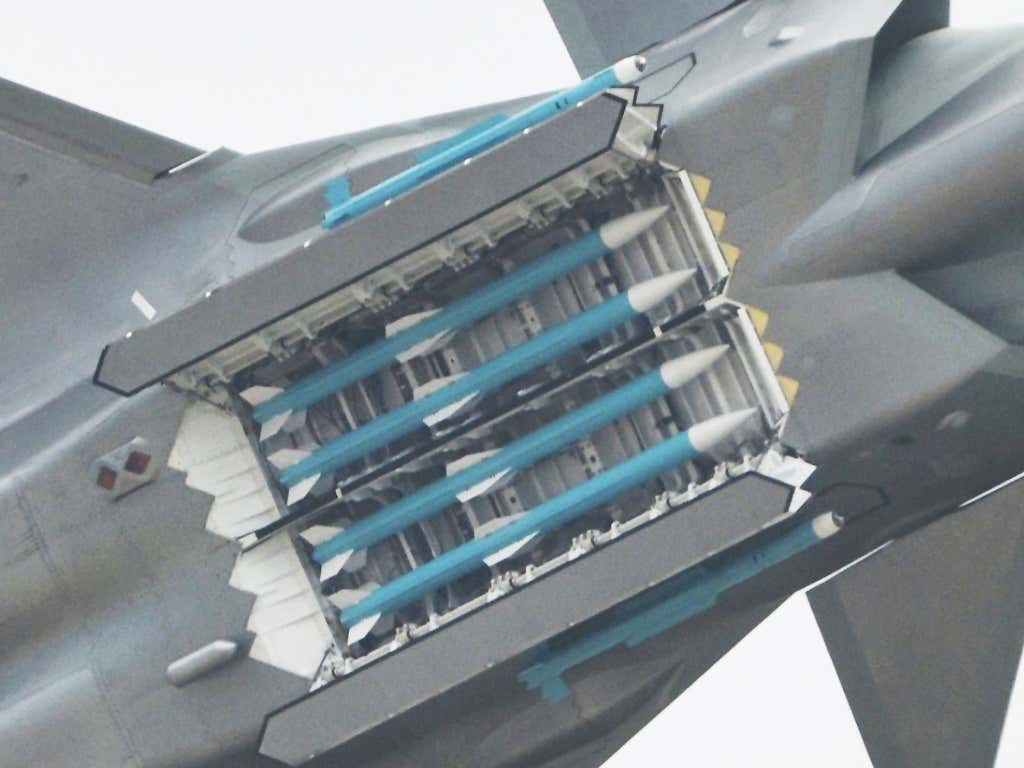
Four dummy PL-15 missiles in the weapons bay of a J-20.
Meanwhile, China has at least been testing another very long-range AAM, photos of which showed it under the wing of a J-16 Flanker multirole fighter jet. This shadowy weapon is thought to be around 18 feet long, compared to 12 feet for the AMRAAM. In the past, The War Zone has speculated about how that weapon may in fact be tailored to destroy airborne early warning and control aircraft, and other high-value targets, at extended ranges.
These Chinese weapons have been under development for some time, as have several Russian counterparts, which pose another threat to the previous dominance of the AMRAAM family. Last year, we saw the first evidence of a test launch of the very long-range R-37M (AA-13 Axehead) from a Su-35S Flanker multirole fighter, while an extended-range version of the R-77 (AA-12 Adder), apparently with ramjet propulsion, also appeared to be under test aboard the Su-57 Felon stealth fighter.
These Chinese and Russian missiles have been known about for some time now — the R-37M was first tested from a MiG-31 Foxhound interceptor as long ago as 2011. This brings us back to the LREW program, which sought to provide the U.S. Air Force with a very long-range AAM to challenge designs like these and to reinstate a capability the Pentagon lost with the Navy’s retirement of the AIM-54 Phoenix in 2004.
Back in late 2017 the National Defense Authorization Act, the Pentagon’s budget, for the following year made reference to the LREW program, which was classed as “emerging capabilities technology development.”
Back then, The War Zone described LREW as follows:
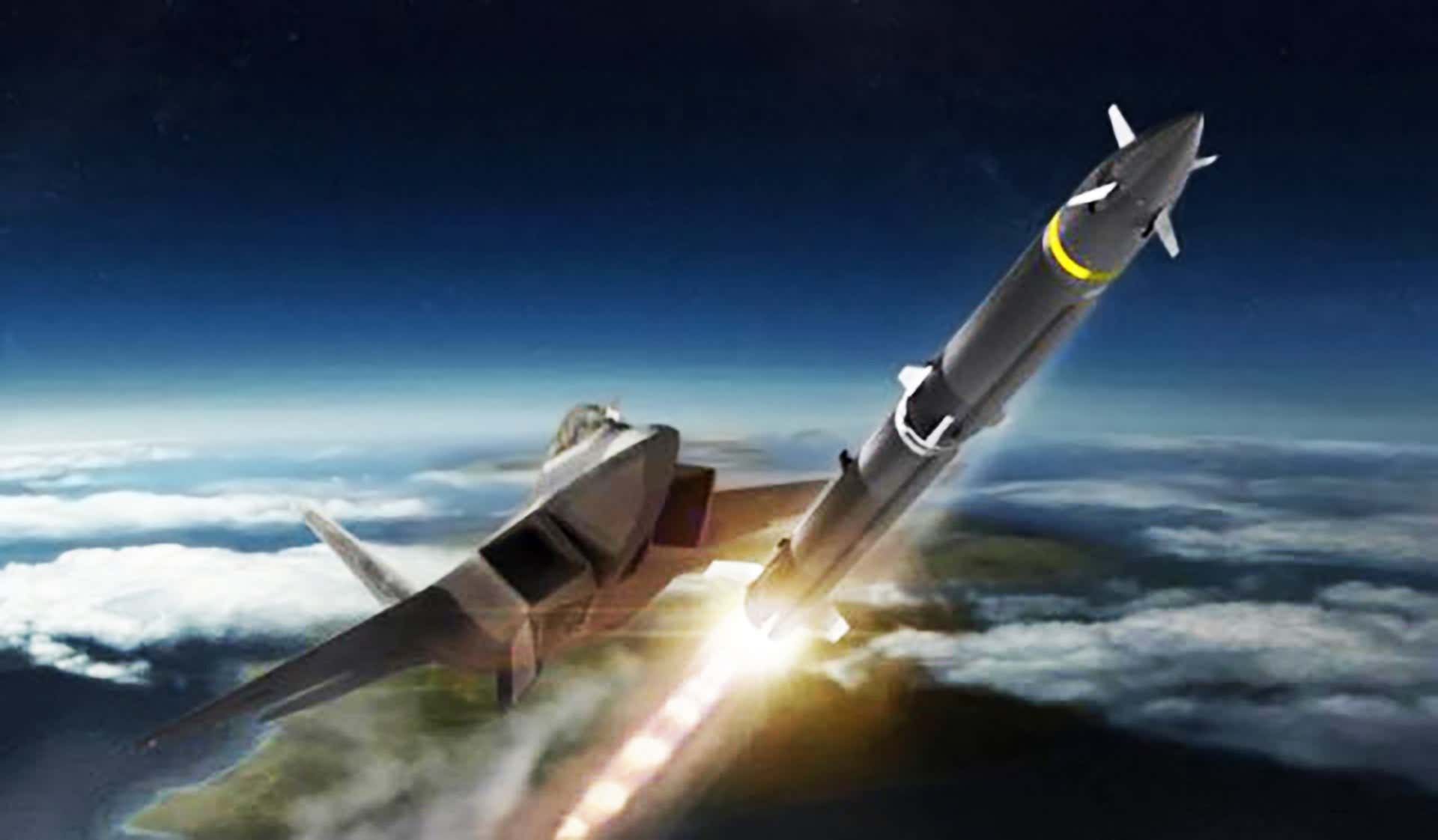
U.S. Air Force concept art showing an F-22 launching a two-stage LREW missile.
While that concept may have involved some artistic license, the unnamed missile mentioned in the recent Air Force sounds very much as if it would be too large for internal carriage. It is possible, perhaps that LREW eventually yielded a missile that was too big for accommodation in the F-22’s main weapons bay. Taken together, however, it suggests that the new weapon is either separate from the LREW program, or the latter has since morphed into a different kind of weapon and one that is larger than when originally conceived.
Moreover, since LREW was first disclosed, the idea of using the F-15 (in particular) as a ‘weapons truck’ has gained much greater traction, including using the older fighter to launch long-range missiles from a position of relative safety well behind a flight of stealth fighters which could provide targeting for these weapons via datalink. With the missile being launched remotely by the F-15, and then fed targeting updates from low-observable assets via datalink, the value of having the weapon launched by the stealth fighter itself becomes more questionable.
There are perhaps other clues in the Air Force’s budget talking points as to how the new missile might be utilized. These make reference to “full-spectrum survivability, high speed, advanced weapons, and extended ranges” as well as a concept of operations in which the Air Force seeks to achieve “temporary windows of superiority” in “highly-contested threat environments.” One can quite easily imagine a very long-range AAM launched from distance and cued by various offboard, primarily stealthy platforms, as a way of punching holes in a dense A2/AD environment such as the kind that would be found during a campaign fought over Taiwan, for instance.
Aside from the F-15EX, there is also the possibility that the new missile could also be compatible with the dimensions of the weapons bays of the B-21 Raider stealth bomber. In 2019, Air Force Major General Scott Pleus, the then Director of Air and Cyber Operations for Pacific Air Forces, talked about the possibility of “A B-21 that also has air-to-air capabilities” and can “work with the family of systems to defend itself, utilizing stealth.”
Regardless, with the F-15EX now making rapid progress, we might not have to wait too long to find out more details about the Air Force’s next-generation very long-range AAM. Whatever that weapon turns out to be, it’s been a long time coming and, with Chinese and Russian missile developments continuing apace, it will likely be a much-needed addition to the service’s armory.
https://www.thedrive.com/the-war-zone/4 ... ir-missile
The disclosure of the mysterious weapon reflects U.S. plans to challenge China’s long-range missile developments.
BY THOMAS NEWDICK

The U.S. Air Force just dropped a big hint that it’s working on a new very long-range air-to-air missile, with the F-15EX Eagle II fighter jet earmarked as the most likely candidate to carry it. The development is the first we’ve heard about a new U.S. air-to-air missile (AAM) in this class since the emergence of the Long Range Engagement Weapon, or LREW, some years ago, followed by that weapon’s apparent disappearance — at least in the public domain.
Details about the new missile were disclosed by Air Force Magazine which recently obtained a series of Air Force talking points for the Fiscal Year 2022 budget. These also talk more generally about the Air Force’s plans to retire over 400 older fighters and replace them with around 300 new aircraft, including the secretive Next Generation Air Dominance (NGAD) program and a ‘clean-sheet’ F-16 replacement, now called the Multi-Role fighter (MR-X).
Intriguingly, the talking points also make reference to an unnamed “outsize … air-to-air” weapon, which will be able to be carried by the F-15EX. The fighter is described in the same papers as “an outsized weapons truck.” To date, the largest air-to-air weapon associated with the F-15EX was the standard AIM-120 Advanced Medium-Range Air-to-Air Missile, or AMRAAM. While the Air Force has continued to try and wring out the maximum possible range from the AMRAAM, that weapon is now surely nearing the end of its development potential.
Previously, the ability of the F-15EX to carry outsized weapons was well known but it was always expected that these would be offensive air-to-ground weapons, including hypersonic missiles which are invariably larger than most regular air-launched missiles. In particular, the AGM-183A Air-launched Rapid Response Weapon, or ARRW, has been touted as a possible future armament option for the F-15EX.
Now, it seems, the F-15EX’s weapons carriage capability will likely see it hauling different types of standoff weapons to prosecute targets both on the ground and in the air. In both scenarios, the F-15EX would likely be operating in less-contested airspace, or just outside hostile anti-access and area denial (A2/AD) umbrellas.
Interestingly, while we know the Air Force, together with the Navy, is already working on a new AAM, which is intended to offer greater range than the current AIM-120 AMRAAM, the AIM-260 has long been assumed to be scaled to similar dimensions as the AMRAAM, especially as the F-22 Raptor is slated to be among the first aircraft to receive it. Having the AIM-260 broadly AMRAAM-sized would ensure it is suitable for internal carriage aboard the F-35 Lightning II, too, as well as any forthcoming stealth fighter designs. The AIM-260 is currently in development but details of its design and capabilities remain classified.
Aside from the AIM-260, there has been speculation in the past that the AGM-88G Advanced Anti-Radiation Guided Missile-Extended Range, or AARGM-ER, a radar-killing air-to-ground weapon, would make a suitable candidate to turn into a long-range AAM. Once again, however, that weapon has been sized from the outset to fit inside the weapons bays of the F-35A and the carrier-based F-35C.
Furthermore, by explicitly referring to the “outsize” nature of this new weapon, the Air Force would seem to be pointing to a different weapon altogether, one that Air Force Magazine assesses as a planned counter to China’s PL-15 AAM.
The PL-15 also remains a mysterious weapon. We know that it is intended as the main armament of the J-20 stealth fighter and that it’s broadly analogous to the AIM-120D AMRAAM. However, there has been speculation in the past surrounding exactly how it achieves its presumed very long-range and whether it uses exotic throttleable ramjet propulsion. In fact, it now seems certain that the PL-15 uses a more conventional dual-pulse motor, but that its overall performance and its active electronically scanned array (AESA) radar still offer a serious challenge to the United States and its allies.

Four dummy PL-15 missiles in the weapons bay of a J-20.
Meanwhile, China has at least been testing another very long-range AAM, photos of which showed it under the wing of a J-16 Flanker multirole fighter jet. This shadowy weapon is thought to be around 18 feet long, compared to 12 feet for the AMRAAM. In the past, The War Zone has speculated about how that weapon may in fact be tailored to destroy airborne early warning and control aircraft, and other high-value targets, at extended ranges.
These Chinese weapons have been under development for some time, as have several Russian counterparts, which pose another threat to the previous dominance of the AMRAAM family. Last year, we saw the first evidence of a test launch of the very long-range R-37M (AA-13 Axehead) from a Su-35S Flanker multirole fighter, while an extended-range version of the R-77 (AA-12 Adder), apparently with ramjet propulsion, also appeared to be under test aboard the Su-57 Felon stealth fighter.
These Chinese and Russian missiles have been known about for some time now — the R-37M was first tested from a MiG-31 Foxhound interceptor as long ago as 2011. This brings us back to the LREW program, which sought to provide the U.S. Air Force with a very long-range AAM to challenge designs like these and to reinstate a capability the Pentagon lost with the Navy’s retirement of the AIM-54 Phoenix in 2004.
Back in late 2017 the National Defense Authorization Act, the Pentagon’s budget, for the following year made reference to the LREW program, which was classed as “emerging capabilities technology development.”
Back then, The War Zone described LREW as follows:
Concept art provided for LREW showed a two-stage missile design being launched from the weapons bay of an F-22. A two-stage weapon would be a logical solution to developing a very long-range AAM rapidly, but the fact that the missile was apparently scaled for internal carriage by the Raptor raises some questions.This program has worked as an exploratory initiative used to identify the overall concept, technologies, kill chain structure, and baseline requirements for a new long-range air-to-air missile or family of missiles. Officially the program is aimed at “maintaining America’s air dominance.” Now the classified results of the program are supposedly being funneled down to the services where they are likely to morph into a hardware development program of record.

U.S. Air Force concept art showing an F-22 launching a two-stage LREW missile.
While that concept may have involved some artistic license, the unnamed missile mentioned in the recent Air Force sounds very much as if it would be too large for internal carriage. It is possible, perhaps that LREW eventually yielded a missile that was too big for accommodation in the F-22’s main weapons bay. Taken together, however, it suggests that the new weapon is either separate from the LREW program, or the latter has since morphed into a different kind of weapon and one that is larger than when originally conceived.
Moreover, since LREW was first disclosed, the idea of using the F-15 (in particular) as a ‘weapons truck’ has gained much greater traction, including using the older fighter to launch long-range missiles from a position of relative safety well behind a flight of stealth fighters which could provide targeting for these weapons via datalink. With the missile being launched remotely by the F-15, and then fed targeting updates from low-observable assets via datalink, the value of having the weapon launched by the stealth fighter itself becomes more questionable.
There are perhaps other clues in the Air Force’s budget talking points as to how the new missile might be utilized. These make reference to “full-spectrum survivability, high speed, advanced weapons, and extended ranges” as well as a concept of operations in which the Air Force seeks to achieve “temporary windows of superiority” in “highly-contested threat environments.” One can quite easily imagine a very long-range AAM launched from distance and cued by various offboard, primarily stealthy platforms, as a way of punching holes in a dense A2/AD environment such as the kind that would be found during a campaign fought over Taiwan, for instance.
Aside from the F-15EX, there is also the possibility that the new missile could also be compatible with the dimensions of the weapons bays of the B-21 Raider stealth bomber. In 2019, Air Force Major General Scott Pleus, the then Director of Air and Cyber Operations for Pacific Air Forces, talked about the possibility of “A B-21 that also has air-to-air capabilities” and can “work with the family of systems to defend itself, utilizing stealth.”
Regardless, with the F-15EX now making rapid progress, we might not have to wait too long to find out more details about the Air Force’s next-generation very long-range AAM. Whatever that weapon turns out to be, it’s been a long time coming and, with Chinese and Russian missile developments continuing apace, it will likely be a much-needed addition to the service’s armory.
https://www.thedrive.com/the-war-zone/4 ... ir-missile
- cabeça de martelo
- Sênior

- Mensagens: 38219
- Registrado em: Sex Out 21, 2005 10:45 am
- Localização: Portugal
- Agradeceram: 2649 vezes
- cabeça de martelo
- Sênior

- Mensagens: 38219
- Registrado em: Sex Out 21, 2005 10:45 am
- Localização: Portugal
- Agradeceram: 2649 vezes
Re: USAF News
Raytheon looks at integrating AMRAAM-ER in F-35A internal carriage
Raytheon Missiles & Defense performed a digital fit check of its AIM-120 Advanced Medium Range Air-to-Air Missile-Extended Range (AMRAAM-ER) variant inside the internal carriage of a Lockheed Martin F-35 stealth fighter.
The engineering effort confirms speculation that the company is looking at offering the extended-range variant not only as a surface-to-air weapon, but also as an air-to-air missile. The disclosure also comes after Raytheon and Kongsberg of Norway completed the first live-fire test of the AMRAAM-ER from the National Advanced Surface-to-Air Missile System (NASAMS) on 12 May at Andoya Space Center in Norway.
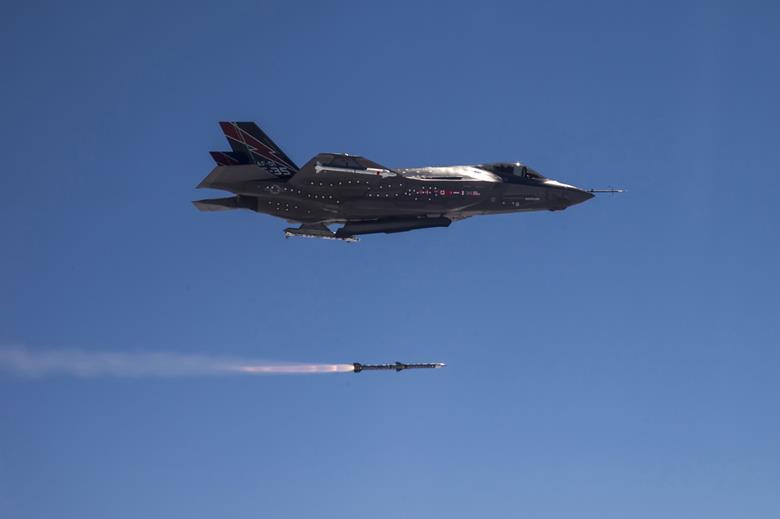
Source: Raytheon
F-35A test fires a standard AMRAAM air-to-air missile off coast of California
AMRAAM-ER is about 16in (40.6cm) longer than the 12ft (3.7m) conventional AMRAAM, says Steve Dickman, Raytheon’s senior director for air dominance on 19 May. The variant is about 3in wider in diameter than the 7in diameter conventional missile.
“So, that’s where you get your additional motor capability: a little bit of length and a little bit of diameter,” he says.
The baseline extended-range variant in production today, intended for the NASAMS battery, uses a Raytheon AMRAAM-C7 guidance section, RIM-162 Evolved SeaSparrow missile rocket motor and control actuation system, Raytheon says. The next production version of AMRAAM-ER will incorporate an AMRAAM-C8 guidance section and a new rocket motor made by Nammo of Norway, along with a new control actuation system made by Kongsberg.
Dickman says the company believes the US Air Force’s (USAF) F-35A could field two examples of the larger missile, one in each internal weapons bay. The F-35A can carry four of the smaller conventional AMRAAMs, two in each internal weapons bay.
Raytheon says it has not yet determined whether the AMRAAM-ER would fit inside the internal weapons bay of the Lockheed Martin F-22 fighter. Presumably, the extended-range variant could also be more easily integrated under the wings and centre-line of fourth-generation combat aircraft already fielding the conventional AMRAAM, such as the Boeing EA-18G, Boeing F/A-18E/F, Boeing F-15, Eurofighter Typhoon, Lockheed Martin F-16, and Saab JAS-39 Gripen.
“Air-launched ARMAAM-ER is not a programme of record. However, we have had discussions with potential domestic and international customers about the capability and continue to fund its development through [internal research and development]”, says Raytheon. “A capability could be delivered three to four years after contract award. This timeline includes an estimate of one year for the operational testing of the new capability.”
When fired from the NASAMS ground battery AMRAAM-ER has a 50% increase in range and 70% increase in altitude over the AIM-120 AMRAAM-C7, according to Kongsberg. It is not clear how that would translate to air-to-air range or performance measures. Raytheon declined to comment on details of performance.
“The AMRAAM-ER design will provide the same or similar target engagement performance as the AMRAAM-C7,” the company says. “The larger rocket motor provides greater range and altitude.”
The range of the AIM-120D has been reported to be about 87nm (161km). However, the exact range of the missile is classified, due to concerns about giving away information about combat aircraft limitations .
NEW SOFTWARE AND HARDWARE ADDS RANGE
Raytheon’s efforts to develop an air-to-air variant of the AMRAAM-ER comes after the company demonstrated the ability to add range to its conventional AMRAAM, some 30 years after the USAF declared the missile had initial operating capability.
The USAF claims that it achieved the longest known air-to-air missile shot in March using an AIM-120D AMRAAM. As part of that test, a Boeing F-15C Eagle fired the missile at a BQM-167 subscale target drone and achieved a “kill” at an undisclosed distance.
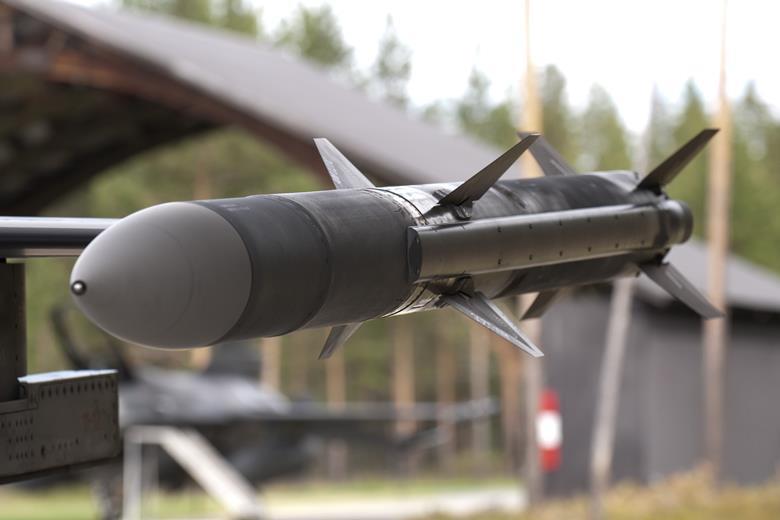
Source: Raytheon
Standard AMRAAM air-to-air missiles could reach farther with software and hardware upgrades, says Raytheon
Raytheon is finding ways to unlock greater range for the AIM-120D AMRAAM with rolling hardware and software updates, says Dickman.
“There’s inherent capability beyond what they typically used it at,” he says. “And, there’s probably some things we could do to change flight profiles, for example, to even squeeze more range out of it. But, those are the [trade studies] that we’re doing.”
Nearly 25,000 examples of AMRAAM have been produced for air forces the world over. All US fighter aircraft use it as the primary beyond-visual-range missile. However, AMRAAM is facing competition from newer weapons, including MBDA’s Meteor and Lockheed Martin’s in-development AIM-260 Joint Advanced Tactical Missile.
The Meteor entered service in 2016 and is thought to have a range greater than the AMRAAM. The missile gets its longer reach from a solid-fueled ramjet motor, which allows it to maintain powered flight in its final stages. Solid rocket-powered missiles, like the AMRAAM, accelerate and then burn out quickly, meaning in the later stages of flight the weapon is effectively coasting – albeit at supersonic speeds – a scenario in which a target aircraft might be able to out manoeuvre it.
The Lockheed Martin AIM-260 is the USAF’s intended replacement for the AIM-120 AMRAAM. The missiles range and propulsion are classified. It is partly a response to China’s PL-15 missile, which is thought to have a range close to 108nm.
The USAF has said that it wants AIM-260 to reach initial operating capability as soon as 2022. Upon successful ramp-up of production of the new missile, it would buy its last AMRAAMs in fiscal year 2026, the service has said.
Still, even if production of the AMRAAM winds down in the mid-2020s, the missile will likely be in the inventories of world air forces for years after that. In March, the Pentagon granted Raytheon a $74 million contract to support flight testing and integration of AMRAAM into current fighters and “next generation platforms that may join the Air Force or Navy inventory before the end of fiscal 2029”.
https://www.flightglobal.com/fixed-wing ... 66.article
Raytheon Missiles & Defense performed a digital fit check of its AIM-120 Advanced Medium Range Air-to-Air Missile-Extended Range (AMRAAM-ER) variant inside the internal carriage of a Lockheed Martin F-35 stealth fighter.
The engineering effort confirms speculation that the company is looking at offering the extended-range variant not only as a surface-to-air weapon, but also as an air-to-air missile. The disclosure also comes after Raytheon and Kongsberg of Norway completed the first live-fire test of the AMRAAM-ER from the National Advanced Surface-to-Air Missile System (NASAMS) on 12 May at Andoya Space Center in Norway.

Source: Raytheon
F-35A test fires a standard AMRAAM air-to-air missile off coast of California
AMRAAM-ER is about 16in (40.6cm) longer than the 12ft (3.7m) conventional AMRAAM, says Steve Dickman, Raytheon’s senior director for air dominance on 19 May. The variant is about 3in wider in diameter than the 7in diameter conventional missile.
“So, that’s where you get your additional motor capability: a little bit of length and a little bit of diameter,” he says.
The baseline extended-range variant in production today, intended for the NASAMS battery, uses a Raytheon AMRAAM-C7 guidance section, RIM-162 Evolved SeaSparrow missile rocket motor and control actuation system, Raytheon says. The next production version of AMRAAM-ER will incorporate an AMRAAM-C8 guidance section and a new rocket motor made by Nammo of Norway, along with a new control actuation system made by Kongsberg.
Dickman says the company believes the US Air Force’s (USAF) F-35A could field two examples of the larger missile, one in each internal weapons bay. The F-35A can carry four of the smaller conventional AMRAAMs, two in each internal weapons bay.
Raytheon says it has not yet determined whether the AMRAAM-ER would fit inside the internal weapons bay of the Lockheed Martin F-22 fighter. Presumably, the extended-range variant could also be more easily integrated under the wings and centre-line of fourth-generation combat aircraft already fielding the conventional AMRAAM, such as the Boeing EA-18G, Boeing F/A-18E/F, Boeing F-15, Eurofighter Typhoon, Lockheed Martin F-16, and Saab JAS-39 Gripen.
“Air-launched ARMAAM-ER is not a programme of record. However, we have had discussions with potential domestic and international customers about the capability and continue to fund its development through [internal research and development]”, says Raytheon. “A capability could be delivered three to four years after contract award. This timeline includes an estimate of one year for the operational testing of the new capability.”
When fired from the NASAMS ground battery AMRAAM-ER has a 50% increase in range and 70% increase in altitude over the AIM-120 AMRAAM-C7, according to Kongsberg. It is not clear how that would translate to air-to-air range or performance measures. Raytheon declined to comment on details of performance.
“The AMRAAM-ER design will provide the same or similar target engagement performance as the AMRAAM-C7,” the company says. “The larger rocket motor provides greater range and altitude.”
The range of the AIM-120D has been reported to be about 87nm (161km). However, the exact range of the missile is classified, due to concerns about giving away information about combat aircraft limitations .
NEW SOFTWARE AND HARDWARE ADDS RANGE
Raytheon’s efforts to develop an air-to-air variant of the AMRAAM-ER comes after the company demonstrated the ability to add range to its conventional AMRAAM, some 30 years after the USAF declared the missile had initial operating capability.
The USAF claims that it achieved the longest known air-to-air missile shot in March using an AIM-120D AMRAAM. As part of that test, a Boeing F-15C Eagle fired the missile at a BQM-167 subscale target drone and achieved a “kill” at an undisclosed distance.

Source: Raytheon
Standard AMRAAM air-to-air missiles could reach farther with software and hardware upgrades, says Raytheon
Raytheon is finding ways to unlock greater range for the AIM-120D AMRAAM with rolling hardware and software updates, says Dickman.
“There’s inherent capability beyond what they typically used it at,” he says. “And, there’s probably some things we could do to change flight profiles, for example, to even squeeze more range out of it. But, those are the [trade studies] that we’re doing.”
Nearly 25,000 examples of AMRAAM have been produced for air forces the world over. All US fighter aircraft use it as the primary beyond-visual-range missile. However, AMRAAM is facing competition from newer weapons, including MBDA’s Meteor and Lockheed Martin’s in-development AIM-260 Joint Advanced Tactical Missile.
The Meteor entered service in 2016 and is thought to have a range greater than the AMRAAM. The missile gets its longer reach from a solid-fueled ramjet motor, which allows it to maintain powered flight in its final stages. Solid rocket-powered missiles, like the AMRAAM, accelerate and then burn out quickly, meaning in the later stages of flight the weapon is effectively coasting – albeit at supersonic speeds – a scenario in which a target aircraft might be able to out manoeuvre it.
The Lockheed Martin AIM-260 is the USAF’s intended replacement for the AIM-120 AMRAAM. The missiles range and propulsion are classified. It is partly a response to China’s PL-15 missile, which is thought to have a range close to 108nm.
The USAF has said that it wants AIM-260 to reach initial operating capability as soon as 2022. Upon successful ramp-up of production of the new missile, it would buy its last AMRAAMs in fiscal year 2026, the service has said.
Still, even if production of the AMRAAM winds down in the mid-2020s, the missile will likely be in the inventories of world air forces for years after that. In March, the Pentagon granted Raytheon a $74 million contract to support flight testing and integration of AMRAAM into current fighters and “next generation platforms that may join the Air Force or Navy inventory before the end of fiscal 2029”.
https://www.flightglobal.com/fixed-wing ... 66.article
- cabeça de martelo
- Sênior

- Mensagens: 38219
- Registrado em: Sex Out 21, 2005 10:45 am
- Localização: Portugal
- Agradeceram: 2649 vezes
Re: USAF News
F-16s Could Still be Flying Into the 2070s
May 23, 2021 By John A. Tirpak

Based on Lockheed Martin’s backlog of F-16 orders, planned upgrades, and the recent revelation that the Air Force plans to depend on the fighter into the late 2030s, the F-16’s sunset years now could come in the 2070s, or later.
Lockheed Martin’s backlog of 128 F-16s—all for foreign military sales—won’t all be delivered until 2026, and the company anticipates more orders may be coming. With a potential service life of 40 years or more, those jets could be flying into the late 2060s or later. The type first entered service in the 1970s.
“There are 25 nations operating F-16s today,” said Col. Brian Pearson, Air Force Life Cycle Management Center lead for F-16 FMS, in a May 17 press release. Lockheed’s Greenville, S.C., F-16 manufacturing and upgrade facility, which will start turning out new F-16s in 2022, “helps us meet the global demand” for F-16 aircraft, he said. Lockheed moved its F-16 work from Fort Worth, Texas, in 2019 to make room there for expanded F-35 production.
Since the new line opened, AFLCMC’s security assistance and cooperation directorate “has seen an uptick of our partner nations requesting detailed information and requests for U.S. government sales,” said Col. Anthony Walker, senior materiel leader in the international division.
The 128 jets are for Bahrain, Bulgaria, Slovakia, Taiwan, and another country the company declined to name, although Croatia and the Philippines have been mentioned as customers. These aircraft will be in the Block 70/72 configuration, which includes new radar, displays, conformal fuel tanks, and other improvements over the Block 50/52 version, the most recent flown by USAF. Lockheed is building F-16s at a rate of about four per month at Greenville.
India is also considering buying an advanced F-16 version Lockheed has dubbed the “F-21,” which Lockheed touts as having a 12,000-hour service life; roughly 50 percent more than the ones the USAF flies. At normal utilization, 12,000 hours is about 32 years of service. India would produce those jets indigenously. India is looking to buy 114 fighters, and Lockheed is partnered with Tata to build the jets if it wins the competition.
Gregory M. Ulmer, Lockheed’s vice president for aeronautics, told reporters in February the company sees a potential for 300 additional F-16 sales not yet on the books, some of which will be to “repeat” customers.
The increased foreign interest may be related to the USAF’s hints over the last two years that it will continue to fly the F-16 beyond previous plans, thus reassuring customers that the parts and support pipeline for a large number of aircraft will persist.
Those hints turned more concrete in recent days. Talking points drawn up for USAF Chief of Staff Gen. Charles Q. Brown Jr. about the service’s future fighter force plans, obtained by Air Force Magazine, indicate the Air Force expects that “600+ late-block F-16s will provide affordable capacity for the next 15+ years,” in both competitive and permissive combat environments. These aircraft will in fact be the USAF’s “capacity force,” the documents say, and will serve as a “rheostat,” meaning their total number can be adjusted up or down depending on the success of the F-35 program and a separate F-16 replacement now known as the Multi-Role-X.
The Air Force considers “competitive” to mean airspace that is reasonably well defended by aircraft and surface-to-air systems. “Highly competitive” and “denied” airspace would only be penetrable by fifth-gen and sixth-gen aircraft with extremely low observable qualities.
Although the fiscal year 2022 budget request, to be released May 28, will reveal some details of the Air Force’s new force structure plans, Brown said at the recent McAleese and Associates defense conference that the meat of the plan will be spelled out in the fiscal ’23 budget.
In the near-term, the USAF plans the divestiture of all the F-16 “pre-blocks” of aircraft, meaning all those that remain in its inventory of the Block 15-25-30 versions.
Lockheed received an indefinite-delivery, indefinite-quantity contract in January worth up to $64.3 billion for production of new F-16s for FMS customers, as well as upgrades of 405 jets in foreign hands to the F-16V configuration, which is similar to the F-21 model proposed to India. These modifications will include “new radar and other upgrades to make them similar to the aircraft that will come off the production line,” AFLCMC’s release said.
The large omnibus contract creates a baseline F-16 configuration for all future production, with the Air Force acting as the agent for FMS customers. Each country will sign a separate contract for unique or custom equipment they want on their particular jets. An Air Force official said the arrangement “simplifies and accelerates” the FMS process for countries wanting to buy the F-16, “so we can get it into their hands faster than has been the case in recent years.” The approach is needed because of the increased expected demand for the airplane, he said. It also reduces the cost of the jet by allowing vendors to make larger, more economic quantities of parts and structural components. The work will also integrate the Joint Mission Planning System/Mission Planning Environment software update.
The contract specifically mentioned work for Bahrain, Bulgaria, Chile, Columbia, Croatia, Egypt, Greece, India, Indonesia, Jordan, Morocco, Korea, Oman, Pakistan, the Philippines, Poland, Romania, Singapore, Slovenia, Taiwan, Thailand, Turkey, and the United Arab Emirates.
Japan flies an F-16 variant, called the F-2, but it performs all work on that type.
More than 4,550 F-16s have been delivered to the U.S. and allied countries since the 1970s. The late Michele A. Evans, Ulmer’s predecessor as Lockheed VP for aeronautics, said in September 2020, the company sees a possibility “of getting up to 5,000” F-16s built. She also said the company views the F-16 as an entrée to its F-35, for countries that are not yet ready to adopt the fifth-generation fighter, but may wish to later.
Brig. Gen. Dale R. White, the USAF’s program executive officer for fighters and advanced aircraft, called the F-16 an “enduring, highly capable compact fighter that will have a large role in many partner nations’ security for years to come.”
https://www.airforcemag.com/f-16s-could ... the-2070s/
May 23, 2021 By John A. Tirpak

Based on Lockheed Martin’s backlog of F-16 orders, planned upgrades, and the recent revelation that the Air Force plans to depend on the fighter into the late 2030s, the F-16’s sunset years now could come in the 2070s, or later.
Lockheed Martin’s backlog of 128 F-16s—all for foreign military sales—won’t all be delivered until 2026, and the company anticipates more orders may be coming. With a potential service life of 40 years or more, those jets could be flying into the late 2060s or later. The type first entered service in the 1970s.
“There are 25 nations operating F-16s today,” said Col. Brian Pearson, Air Force Life Cycle Management Center lead for F-16 FMS, in a May 17 press release. Lockheed’s Greenville, S.C., F-16 manufacturing and upgrade facility, which will start turning out new F-16s in 2022, “helps us meet the global demand” for F-16 aircraft, he said. Lockheed moved its F-16 work from Fort Worth, Texas, in 2019 to make room there for expanded F-35 production.
Since the new line opened, AFLCMC’s security assistance and cooperation directorate “has seen an uptick of our partner nations requesting detailed information and requests for U.S. government sales,” said Col. Anthony Walker, senior materiel leader in the international division.
The 128 jets are for Bahrain, Bulgaria, Slovakia, Taiwan, and another country the company declined to name, although Croatia and the Philippines have been mentioned as customers. These aircraft will be in the Block 70/72 configuration, which includes new radar, displays, conformal fuel tanks, and other improvements over the Block 50/52 version, the most recent flown by USAF. Lockheed is building F-16s at a rate of about four per month at Greenville.
India is also considering buying an advanced F-16 version Lockheed has dubbed the “F-21,” which Lockheed touts as having a 12,000-hour service life; roughly 50 percent more than the ones the USAF flies. At normal utilization, 12,000 hours is about 32 years of service. India would produce those jets indigenously. India is looking to buy 114 fighters, and Lockheed is partnered with Tata to build the jets if it wins the competition.
Gregory M. Ulmer, Lockheed’s vice president for aeronautics, told reporters in February the company sees a potential for 300 additional F-16 sales not yet on the books, some of which will be to “repeat” customers.
The increased foreign interest may be related to the USAF’s hints over the last two years that it will continue to fly the F-16 beyond previous plans, thus reassuring customers that the parts and support pipeline for a large number of aircraft will persist.
Those hints turned more concrete in recent days. Talking points drawn up for USAF Chief of Staff Gen. Charles Q. Brown Jr. about the service’s future fighter force plans, obtained by Air Force Magazine, indicate the Air Force expects that “600+ late-block F-16s will provide affordable capacity for the next 15+ years,” in both competitive and permissive combat environments. These aircraft will in fact be the USAF’s “capacity force,” the documents say, and will serve as a “rheostat,” meaning their total number can be adjusted up or down depending on the success of the F-35 program and a separate F-16 replacement now known as the Multi-Role-X.
The Air Force considers “competitive” to mean airspace that is reasonably well defended by aircraft and surface-to-air systems. “Highly competitive” and “denied” airspace would only be penetrable by fifth-gen and sixth-gen aircraft with extremely low observable qualities.
Although the fiscal year 2022 budget request, to be released May 28, will reveal some details of the Air Force’s new force structure plans, Brown said at the recent McAleese and Associates defense conference that the meat of the plan will be spelled out in the fiscal ’23 budget.
In the near-term, the USAF plans the divestiture of all the F-16 “pre-blocks” of aircraft, meaning all those that remain in its inventory of the Block 15-25-30 versions.
Lockheed received an indefinite-delivery, indefinite-quantity contract in January worth up to $64.3 billion for production of new F-16s for FMS customers, as well as upgrades of 405 jets in foreign hands to the F-16V configuration, which is similar to the F-21 model proposed to India. These modifications will include “new radar and other upgrades to make them similar to the aircraft that will come off the production line,” AFLCMC’s release said.
The large omnibus contract creates a baseline F-16 configuration for all future production, with the Air Force acting as the agent for FMS customers. Each country will sign a separate contract for unique or custom equipment they want on their particular jets. An Air Force official said the arrangement “simplifies and accelerates” the FMS process for countries wanting to buy the F-16, “so we can get it into their hands faster than has been the case in recent years.” The approach is needed because of the increased expected demand for the airplane, he said. It also reduces the cost of the jet by allowing vendors to make larger, more economic quantities of parts and structural components. The work will also integrate the Joint Mission Planning System/Mission Planning Environment software update.
The contract specifically mentioned work for Bahrain, Bulgaria, Chile, Columbia, Croatia, Egypt, Greece, India, Indonesia, Jordan, Morocco, Korea, Oman, Pakistan, the Philippines, Poland, Romania, Singapore, Slovenia, Taiwan, Thailand, Turkey, and the United Arab Emirates.
Japan flies an F-16 variant, called the F-2, but it performs all work on that type.
More than 4,550 F-16s have been delivered to the U.S. and allied countries since the 1970s. The late Michele A. Evans, Ulmer’s predecessor as Lockheed VP for aeronautics, said in September 2020, the company sees a possibility “of getting up to 5,000” F-16s built. She also said the company views the F-16 as an entrée to its F-35, for countries that are not yet ready to adopt the fifth-generation fighter, but may wish to later.
Brig. Gen. Dale R. White, the USAF’s program executive officer for fighters and advanced aircraft, called the F-16 an “enduring, highly capable compact fighter that will have a large role in many partner nations’ security for years to come.”
https://www.airforcemag.com/f-16s-could ... the-2070s/
- jambockrs
- Sênior

- Mensagens: 2617
- Registrado em: Sex Jun 10, 2005 1:45 am
- Localização: Porto Alegre/RS
- Agradeceram: 180 vezes
Re: USAF News
Meus prezados
Força Aérea dos EUA lança concorrência do avião-tanque KC-Y
Por Redação Forças de Defesa
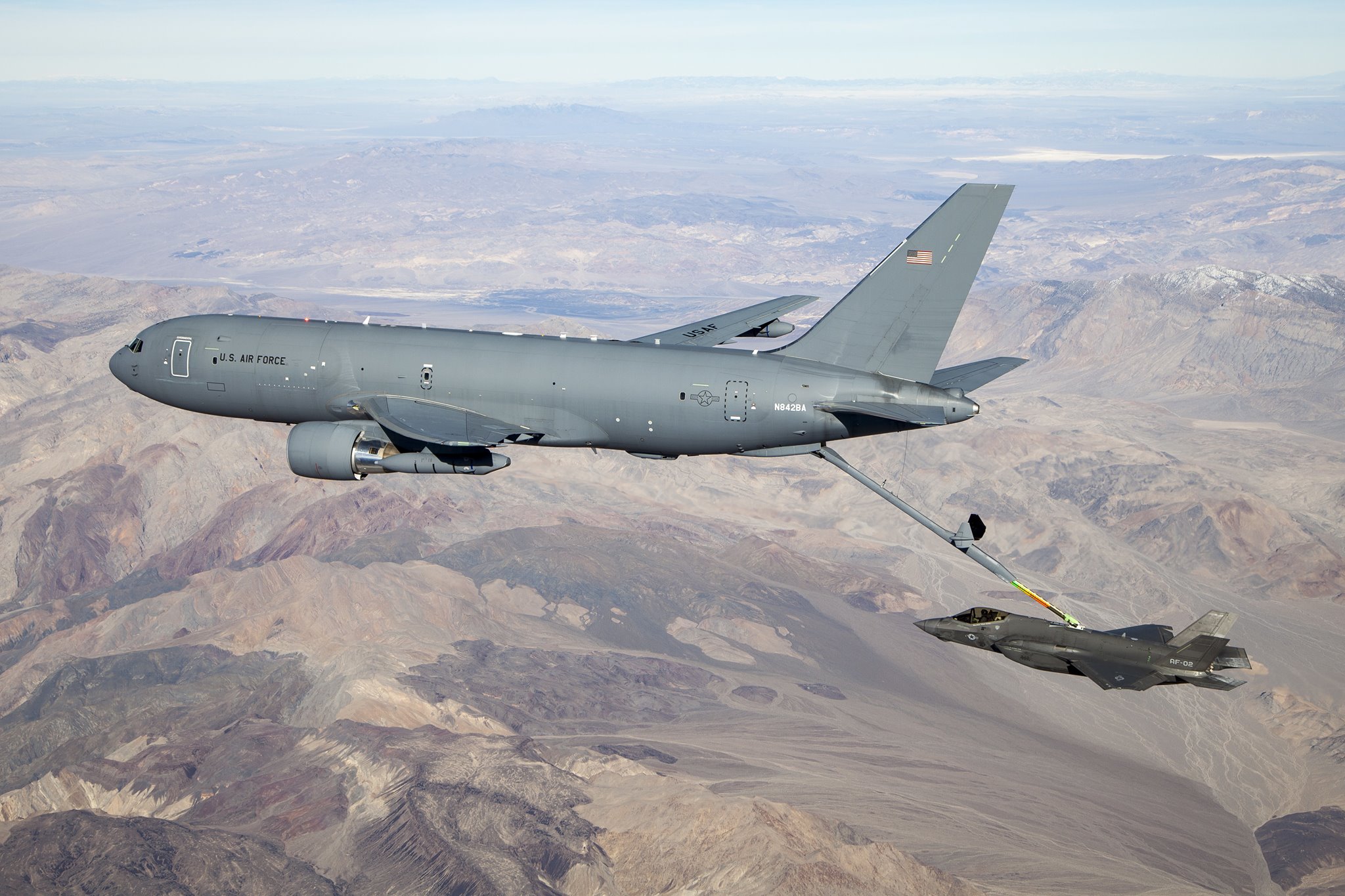
A Força Aérea dos Estados Unidos (USAF) lançou formalmente sua competição de aviões-tanque KC-Y, com um pedido de informações (RFI) emitido em 16 de junho.
Conhecido também como Bridge Tanker, o requisito KC-Y é para uma aeronave comercial de reabastecimento aéreo para complementar a frota da USAF assim que as entregas do Boeing KC-46A Pegasus forem concluídas no final da década.
“A nova aeronave preencherá a lacuna do KC-X para a próxima fase de recapitalização do Advanced Air Refueling Tanker, anteriormente conhecida como KC-Z. O contrato de preço fixo existente do KC-46A está limitado a 13 lotes de produção, com a última aquisição planejada em 2027 e entrega em 2029 ”, disse o Centro de Gerenciamento do Ciclo de Vida da Força Aérea (AFLCMC). “Os requisitos para o Bridge Tanker estão sendo definidos e os recursos necessários serão incorporados à solicitação final de proposta (RFP), uma vez que seja validada através do processo de recrutamento conjunto do Departamento de Defesa. A Força Aérea dos EUA planeja liberar o RFP final até o final de 2022.”
Com as entregas do KC-Y programadas para começar em 2029, a USAF espera receber entre 140 e 160 novos aviões-tanque a uma cadência de 12 a 15 por ano. Conforme observado pelo AFLCMC, como uma aeronave comercialmente derivada, o Bridge Tanker será baseado em tecnologias existentes e emergentes com uma concorrência de aquisição total e aberta. Nem furtividade de desenvolvimento nem capacidade não tripulada são planejadas.
Fonte: Jane’s via blog Poder Aéreo 18 jun 2021
O imbróglio do Pegasus nem terminou e já abriram um RFI para outra aeronave?
Força Aérea dos EUA lança concorrência do avião-tanque KC-Y
Por Redação Forças de Defesa

A Força Aérea dos Estados Unidos (USAF) lançou formalmente sua competição de aviões-tanque KC-Y, com um pedido de informações (RFI) emitido em 16 de junho.
Conhecido também como Bridge Tanker, o requisito KC-Y é para uma aeronave comercial de reabastecimento aéreo para complementar a frota da USAF assim que as entregas do Boeing KC-46A Pegasus forem concluídas no final da década.
“A nova aeronave preencherá a lacuna do KC-X para a próxima fase de recapitalização do Advanced Air Refueling Tanker, anteriormente conhecida como KC-Z. O contrato de preço fixo existente do KC-46A está limitado a 13 lotes de produção, com a última aquisição planejada em 2027 e entrega em 2029 ”, disse o Centro de Gerenciamento do Ciclo de Vida da Força Aérea (AFLCMC). “Os requisitos para o Bridge Tanker estão sendo definidos e os recursos necessários serão incorporados à solicitação final de proposta (RFP), uma vez que seja validada através do processo de recrutamento conjunto do Departamento de Defesa. A Força Aérea dos EUA planeja liberar o RFP final até o final de 2022.”
Com as entregas do KC-Y programadas para começar em 2029, a USAF espera receber entre 140 e 160 novos aviões-tanque a uma cadência de 12 a 15 por ano. Conforme observado pelo AFLCMC, como uma aeronave comercialmente derivada, o Bridge Tanker será baseado em tecnologias existentes e emergentes com uma concorrência de aquisição total e aberta. Nem furtividade de desenvolvimento nem capacidade não tripulada são planejadas.
Fonte: Jane’s via blog Poder Aéreo 18 jun 2021
O imbróglio do Pegasus nem terminou e já abriram um RFI para outra aeronave?


